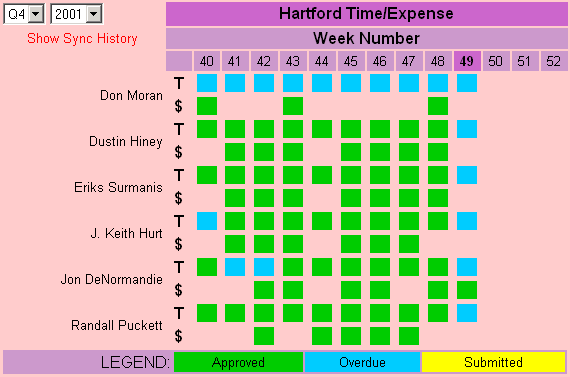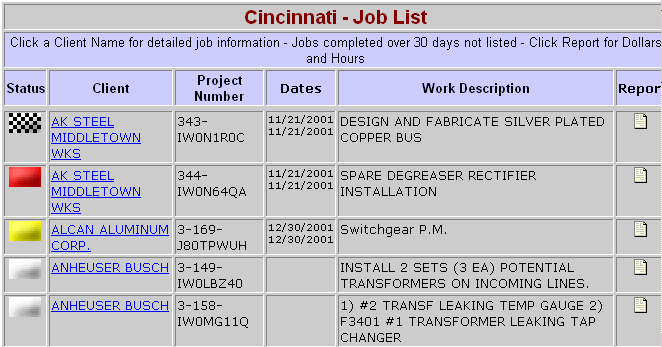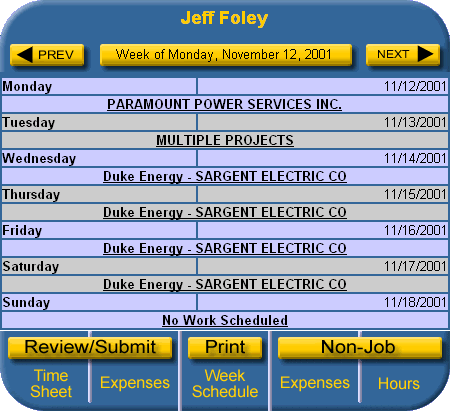CASE
STUDY - GRAND EAGLE SERVICES DISPATCH BOARD
Ideate, LLC - Developer
Situation
Grand Eagle is North America's largest independent supplier of comprehensive
motor, switchgear and transformer services.
Grand Eagle’s Power Systems Group provides on-site field service and upgrades
for power switchgear from more than 55 dispatch points across the nation. Skilled
power systems technicians and engineers provide maintenance, scheduled and unscheduled
outage services, project management, power systems studies, as well as design
and upgrade engineering services. This group also specializes in the repair
and remanufacturing of low- and medium-voltage circuit breakers used in manufacturing,
processing, utility, and nuclear power facilities. The company responds to scheduled
service calls as well as emergency calls from it's clients.
With varied technical expertise scattered in over 55 dispatch points, the company
thought it could improve customer service by sharing the hourly availability
and areas of expertise of each and every engineer between all the dispatch points.
In this way, the company could import it's own expertise from anywhere in the
country to respond to the needs of it's customers.
Problem Definition
The developer, Ideate LLC,
partnered with one of the dispatch points to work with the managers, administrators
and engineers to define the scope of the project. It was clear that the success
of the project depended upon the benefits it provided to every individual user-type.
Existing web-based solutions were reviewed, and found to be too generic or
too expensive for company-wide implementation. All were proprietary solutions,
which would be a risky investment given the volatility of web-based service
providers' business models. Grand Eagle decided it was important to have access
to both the data and the source code to ensure maintainability in the future.
Upper Management: Senior managers needed to track the efficiency and
utilization of each division, region, plant and engineer. They required these
figures to be calculated by administrators at each dispatch point on a monthly
basis, with spreadsheets sent to the main office for further analysis. This
meant the figures were over a month old before they were seen. The developer
felt that up to the minute engineer efficiency pipeline reporting would be a
compelling benefit to upper management.
Manager-Scheduler: The manager, responding to service calls from customers,
traditionally used a magnetic whiteboard to keep track of engineer schedules.
The schedule for each engineer from that dispatch point - for a two-week period
- was tracked with colored erasable markers. At the end of each week, the board
was erased and redrawn for the new week. Work scheduled more than two weeks
ahead were noted elsewhere and transferred to the board when the time came.
Those without access to the whiteboard could not reliably schedule work. The
managers also had to transfer this information to their internal job-cost system
and to written schedules sent or faxed to each field engineer. The managers
primarily wanted to be able to see the schedules of the engineers from other
dispatch points. The developer felt that creating a perpetual calendar for scheduling
accessible to all qualified schedulers, sharing schedules for all dispatch points,
and eliminating unnecessary hand copying would be a compelling benefit for dispatch
managers and schedulers.
Administrators: Administrators were responsible for transferring information
to and from the field engineers, transcribing schedules, time sheets and expense
sheets to an internally developed job costing system. The developer felt that
eliminating transcription and telephone tag would be a compelling benefit for
dispatch point administrators.
Field Engineers: Field Engineers working evenings and weekends often
could not reach the dispatch point during business hours for schedule updates.
They had to fax or phone in timesheet and expense information, and practiced
telephone tag for updates to their schedules. The developer felt that the ability
for the engineer to check his schedule and enter time sheet and expense data
at any time of the day or night would be a compelling benefit for the field
engineers. Response time would also be a factor for engineers, since some would
be calling in from phone lines of varying quality and line speeds.
The Solution:
 The
solution is a custom web application built with Microsoft Visual FoxPro,
Windows 2000 Server, Internet Information Services 5, West Wind Web Connect,
and Amyuni PDF Creator (to generate dynamic PDF reports) - using Internet
Explorer and Acrobat Reader for the client application. The Grand Eagle
Dispatch Board is accessible from any location with Internet access. The
solution is a custom web application built with Microsoft Visual FoxPro,
Windows 2000 Server, Internet Information Services 5, West Wind Web Connect,
and Amyuni PDF Creator (to generate dynamic PDF reports) - using Internet
Explorer and Acrobat Reader for the client application. The Grand Eagle
Dispatch Board is accessible from any location with Internet access. |
|

Pipeline Reporting: Upper management can monitor up to the minute
efficiency reports company wide or drill down to reports by zone, by region,
by plant, and by individual engineer - including projected efficiency
for scheduled projects. They can also compare schedules for all plants
on a single screen.
|

Instant Scheduling: Plant managers schedule new projects and track
project expenses and hours. They can also verify engineer availability for
specific projects, and search the resumes of all Grand Eagle Field Engineers
worldwide for those with a particular expertise. They no longer need to
spend hours assembling monthly efficiency reports. Their plant's bookings
are intuitively displayed using color-coding. |

Administrative Process Dashboard: Plant administrators can review
and approve timesheets and expense reports on-line. A single diagram indicates
the status of each employee's timesheets and expenses by week. Hours and
expenses are downloaded to their accounting applications with a single click
- and no re-keying is required. |

Project Summary Reports: Project managers can review the status of
each of their projects at a glance using color-coded status flags. They
can drill-down to a detailed report of their project's hours and expenses.
When they mark a project as complete, e-mail notification is launched to
initiate the close-out process. |

Schedule, Timesheet and Expense Reporting: Field engineers can check
their schedules at any time of the day or night, and can post their hours
and expenses against the estimated amounts for each project. They can view
job details, and print out their daily or weekly schedule. They can review
and submit their timesheets and expenses on-line without faxes. |
Benefits:
The dispatch board's intuitive, web-based interface is easy to use and learn.
To train new users, team leaders call each dispatch point for an hour or two
of training. Ease of training is enhanced through compartmentalization of features
for each user group. The system - with sub-second response times - allows everyone
a global overview of engineer schedules and availability - as well as drill-down
access to details of every job. The skills and experience of each engineer is
searchable, so that any scheduler can list all engineers meeting the skill requirements
of any prospective job - as well as launch an e-mail to that engineer's plant
manager to reserve his time.
Management can now schedule engineers regardless of location - making dispatch
point locations and company organization more flexible. Engineers enter their
hours and expenses once on the system - and administrators later synchronize
new information to their local job-costing system with no transcription necessary.
Salesmen know engineer availability at a glance - by dispatch point, by region,
or globally.
Updates and modifications are made transparently to the users - with no client
software except their browser and Acrobat Reader. Support has proved to be minimal.
Development was rapid. Development progress was accessible at all times on
the web for the team at the first planned dispatch point - allowing for dynamic
feedback, quick response and the ability to rapidly narrow on the ideal solution.
Suggestions continue to be quickly rolled into the product with no downtime.
This kind of immediate gratification leads to interest and commitment on the
part of the end users. According to the VP in charge, "It was the most
progressive task accomplished during the restructuring of the Breaker BDU at
Grand Eagle."
 The
solution is a custom web application built with Microsoft Visual FoxPro,
Windows 2000 Server, Internet Information Services 5, West Wind Web Connect,
and Amyuni PDF Creator (to generate dynamic PDF reports) - using Internet
Explorer and Acrobat Reader for the client application. The Grand Eagle
Dispatch Board is accessible from any location with Internet access.
The
solution is a custom web application built with Microsoft Visual FoxPro,
Windows 2000 Server, Internet Information Services 5, West Wind Web Connect,
and Amyuni PDF Creator (to generate dynamic PDF reports) - using Internet
Explorer and Acrobat Reader for the client application. The Grand Eagle
Dispatch Board is accessible from any location with Internet access.



